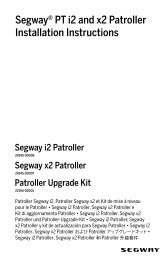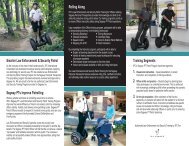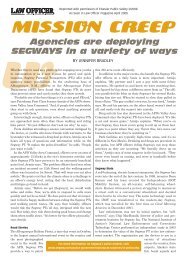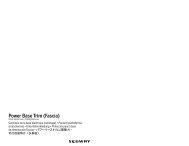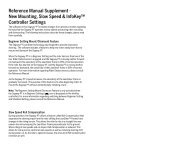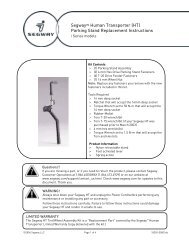Lithium Ion Battery (PDF) - Segway
Lithium Ion Battery (PDF) - Segway
Lithium Ion Battery (PDF) - Segway
You also want an ePaper? Increase the reach of your titles
YUMPU automatically turns print PDFs into web optimized ePapers that Google loves.
MATERIAL SAFETY DATA SHEET<br />
Valence <strong>Battery</strong><br />
Emergency Contact: CHEMTREC at 1-800-424-9300<br />
(Locations outside of the US, call collect +1 703 527 3887)<br />
In the event of a chemical related emergency contact CHEMTREC<br />
immediately!<br />
12303 Technology Blvd.<br />
Suite 950<br />
Austin, TX 78727<br />
1-888-VALENCE<br />
www.valence.com
Section 1: Company Identification<br />
Manufacturer:<br />
Valence Technology, Inc.<br />
Customer Support:<br />
1) 8 AM to 5 PM CST<br />
1-888-VALENCE (1-888-825-3623 USA Customers Only)<br />
(001) 512-527-2900<br />
For European, Middle East, Africa, Asia, and Australia Support<br />
+44 (0) 2890 845400 (N. Ireland)<br />
8 AM to 5 PM GMT<br />
Sales:<br />
1-888-825-3623<br />
Fax:<br />
1-512-527-2910<br />
Sales Email:<br />
u-charge@valence.com<br />
Support Email:<br />
support@valence.com<br />
Mailing Address:<br />
Valence Technology, Inc.<br />
12303 Technology Blvd.<br />
Suite 950<br />
Austin, TX 78727<br />
Preparation Date<br />
08/09/01<br />
Revision Date<br />
01/24/13
Section 2: Product Summary and Detail<br />
2.1 Product Detail<br />
Product Name (Generic) <strong>Lithium</strong>-ion <strong>Battery</strong> Packs, <strong>Lithium</strong>-ion Cells<br />
Commercial Names<br />
U-Charge Batteries: U1-12RT, U1-24RT, U1-12XP,<br />
U1-12BMS, U24-12XP, U27-12XP, U27-36XP,<br />
UEV-12XP, P40-24,<br />
Valence Cells: IFR18650e, IFR26650PC<br />
Nominal Voltage 12V, 25V, 19V, 3.2V<br />
Nominal Capacity<br />
40Ah, 45Ah, 69Ah, 110Ah, 138Ah, 1.35Ah, 2.5Ah<br />
Chemical System<br />
<strong>Lithium</strong>-iron Phosphate / Carbon<br />
Designed for Recharge Yes<br />
Packing Requirements Packing Group II<br />
UN Number<br />
UN3480<br />
(UN3090 for US Ground Shipments)<br />
2.2 Composition and Ingredient Information<br />
Chemical Name CAS # Exposure Limits Percent of<br />
Content<br />
<strong>Lithium</strong> Iron Magnesium 349632-76-4 0.19 mg/kg/h (TWA) 20-35%<br />
Phosphate 1. 10.50 mg/m 3 (OEL)<br />
Carbon Black 1. 1333-86-4 3.5 mg/m 3 (TWA) 1-5%<br />
3.5 mg/m 3 (OEL)<br />
Graphite 7782-42-5 None Listed 5-15%<br />
<strong>Lithium</strong><br />
Mixture None Listed 5-15%<br />
hexafluorophosphate in<br />
mixed carbonate solvents<br />
Notes:<br />
1. Some components present in the battery are registered on EPA’s Toxic Substance Control Act (TSCA)<br />
Inventory List. TLV – Threshold Limit Value; TWA – Time Weighted Average; OEL – Occupational<br />
Exposure Limit<br />
The battery should not be opened or burned or otherwise exposed to fire or high heat.<br />
Do not disassemble, open, crush, puncture, incinerate, short across the terminals or<br />
install with incorrect polarity. The batteries are incompatible with water, moisture,<br />
oxidizing agents, reducing agents, acids and bases. Exposure to the ingredients<br />
contained within or their discharge/combustion products could be harmful under some<br />
circumstances. The materials in this section may only represent any hazard if the integrity of<br />
the battery is compromised or if the battery is physically or electrically abused.<br />
This battery is an article pursuant to 29 CFR 1910.1200 and, as such, is not subject to the<br />
OSHA hazard communication standard requirement.
2.3 Physical and Chemical Properties<br />
Physical State<br />
Vapor Pressure (MMHg@ 20 DEG. C)<br />
Appearance<br />
Vapor Density (Air = 1)<br />
pH<br />
Solubility in Water<br />
Relative Density (Water = 1)<br />
Water/Oil Distribution Coefficient<br />
Boiling Point<br />
Odor Type<br />
Melting Point<br />
Odor Threshold<br />
Viscosity<br />
Evaporation Rate (n-Butyl Acetate = 1)<br />
Oxidizing Properties<br />
Auto Ignition Temperature (DEG. C)<br />
Flash Point and Method (DEG. C)<br />
Flammability Limits (%)<br />
Solid<br />
Not Applicable<br />
<strong>Battery</strong>, <strong>Battery</strong> Pack<br />
Not Applicable<br />
Not Applicable<br />
Insoluble<br />
Not Available<br />
Not Applicable<br />
Not Applicable<br />
Odorless<br />
Not Applicable<br />
Not Applicable<br />
Not Applicable<br />
Not Applicable<br />
Not Applicable<br />
Not Applicable<br />
Not Applicable<br />
Not Applicable<br />
Section 3: Exposure Controls and personal Protection<br />
3.1 Engineering Controls<br />
Use local exhaust ventilation or other engineering controls to control sources of dust, mist,<br />
fume and vapor.<br />
3.2 Personal Protection<br />
Not required during normal handling. Where protective clothing when handling an open, or<br />
leaking battery.<br />
3.3 Respiratory Protection<br />
Not required during normal handling. Where concentration may exceed OSHA/ACGIH<br />
permissible limits, use approved respiratory protection.<br />
3.4 Protective Gloves<br />
Not required under normal conditions. Wear nitrile gloves if handling an open or leaking battery<br />
they are more chemically resistant that latex gloves. Neoprene or natural rubber gloves can<br />
be used if nitrile gloves are not available.
3.5 Eye Protection<br />
Not required under normal conditions. Wear safety glasses or side shields if handling an open<br />
or leaking battery.<br />
3.6 Other Protective Equipment/Work Practices<br />
Handle with care. Do not short positive and negative terminals. Do not eat, drink or smoke in<br />
work areas. Maintain good housekeeping practices in the work area to promote safety.<br />
Section 4: Health Hazards Identification<br />
Class of division is 9. This product is safe under normal use. The battery should not be<br />
opened or burned. Exposure to the ingredients contained within and/or their combustion<br />
products could be harmful.<br />
These chemicals are contained in a sealed enclosure. Risk of exposure occurs only if the<br />
battery is mechanically, thermally or electrically abused to the point of compromising the<br />
enclosure. If this occurs, exposure to the battery electrolyte solution within can occur by<br />
inhalation, ingestion, eye contact and skin contact.<br />
In the event of exposure to the battery contents the following potential health effects could<br />
occur.<br />
• Acute effects - Vapor or mist is irritation to the eyes, mucous membranes and<br />
Respiratory tract. Can cause eye and skin irritation. Exposure can cause nausea,<br />
dizziness and headache. The electrolyte solution contained within the battery would be<br />
corrosive and can cause burns.<br />
• Chronic effects - Overexposure may cause reproductive disorder(s) based on tests<br />
with laboratory animals. Target organs affected could be kidneys, central nervous<br />
system, eyes, and male reproductive system.<br />
Section 5: First Aid Measures<br />
5.1 Inhalation<br />
Inhalation of material from a sealed battery is not an expected route of exposure. Vapors or<br />
mists from a compromised battery may cause respiratory irritation. If contents of an opened<br />
battery are inhaled, remove source of contamination and move victim to fresh air. If breathing<br />
is difficult, give oxygen. If not breathing, give artificial respiration and obtain medical attention.<br />
5.2 Eye Contact<br />
Only contact with the contents of an opened battery can cause sever irritation or burns to the<br />
eye. If eye contact with contents of an open battery occurs, immediately flush the<br />
contaminated eye(s) with copious amounts of water (or normal saline) for at least 15 minutes.
Assure adequate flushing of the eyes by separating the eyelids with finger and thumb. If<br />
irritation or pain persists, seek medical attention.<br />
5.3 Skin Contact<br />
Contact between the skin and battery will not cause harm. Contact with the contents of an<br />
opened battery, mainly the electrolyte solution can cause severe irritation or burns to the skin.<br />
Immediately flush thoroughly with soap, or mild detergent and copious amounts of water until<br />
no evidence of substance remains (typically 15-20 minutes). Remove and wash contaminated<br />
clothing promptly. If irritation or pain persists, seek medical attention.<br />
5.4 Ingestion<br />
Swallowing of a sealed battery is not an expected route of exposure. In the event that<br />
swallowing of materials from a compromised battery occurs, serious chemical burns of the<br />
mouth, esophagus, and gastrointestinal tract can occur. If swallowed, wash out mouth with<br />
water provided person is conscious. Quickly transport victim to an emergency care facility.<br />
Section 6: Fire Fighting Measures<br />
6.1 Flammable Properties<br />
In the event that this battery has been ruptured, the electrolyte solution contained within the<br />
battery WILL BE flammable. Like any sealed container, battery cells may rupture when<br />
exposed to excessive heat and could result in the release of flammable or corrosive materials.<br />
6.2 Extinguishing Media<br />
Use water, carbon dioxide, dry chemical or appropriate foam to extinguish fire.<br />
6.3 Special Fire Fighting Procedures<br />
Fires involving lithium batteries can be controlled with water. When water is used, however,<br />
hydrogen gas may evolve. In a confined space, hydrogen gas can form an explosive mixture.<br />
In this situation, smothering agents are recommended to extinguish the fire. Ruptured cells<br />
may emit irritating and/or toxic fumes under fire conditions.<br />
6.4 Protective Equipment and Precautions for Firefighters<br />
Wear NIOSH/MSHA approved self-contained breathing apparatus (SCBA) and protective<br />
clothing when fighting chemical fires.<br />
Section 7: Accidental Release Measures<br />
7.1 Personal Precautions<br />
Restrict access to contaminated area until completion of clean-up. DO NOT touch the spilled<br />
material. Wear suitable protective clothing, nitrile gloves, eye/face protection and respirator<br />
with filters for dust particles.
7.2 Environmental Precautions<br />
DO NOT let product enter drainage system, surface and/or ground-water and soil. Do not<br />
flush down sewers or waterways. Consult federal, state or local authorities for disposal<br />
procedures.<br />
7.3 Methods for Containment<br />
Stop the spill if safe to do so. Contain the spilled liquid with dry sand, earth or approved spill<br />
absorber. Clean up spills immediately.<br />
7.4 Methods for Clean Up<br />
1. Wear full protective clothing to prevent direct contact with the skin as well as nitrile<br />
gloves and eye protection and respiratory protection when dealing with spilled battery<br />
material.<br />
2. Soak up the spilled material with inert absorbent material such at dry sand or earth or a<br />
commercial absorbing agent to avoid dispersing dust into the air or use a wet-down<br />
procedure or a heap-vacuum.<br />
3. Collect all absorbent material and dispose of per section 8.<br />
4. Once the area is clear of absorbent material be sure to wash the surface with plenty of<br />
water and detergent. Do not let the contaminated water enter the sewer or drain system.<br />
5. Consult federal, state or local authorities for disposal procedures. Depending on<br />
quantity, location and status of user, materials may be considered a hazardous waste<br />
product.<br />
Section 8: Disposal Considerations<br />
8.1 Waste Disposal Method<br />
<strong>Battery</strong> recycling is encouraged. Do not dump into any sewers, on the ground or into any body<br />
of water. Store material for disposal as indicated in Section 7 handling and storage. Dispose of<br />
in accordance with local, state and federal laws and regulations.<br />
NOTE: All hazardous waste containing material from Valence Batteries or Cells<br />
should be disposed of in a licensed facility.<br />
Section 9: Handling and Storage<br />
9.1 Handling<br />
Do not open, dissemble, crush or burn battery. Do not expose battery to extreme heat or fire.<br />
Wear suitable protective clothing, nitrile gloves, eye/face protection and respirator for dust.
9.2 Storage<br />
When not being used, store battery in cool, dry, and well-ventilated area. Avoid storing in or<br />
near excessive heat. Elevated temperatures can result in shortened battery life. Keep out of<br />
reach of children.<br />
• Room Ventilation: Cool, dry and well-ventilated area<br />
• Special Precautions: Do not store near sources of ignition due to carbon black<br />
• Recommended Temperature: Room temperature, not to exceed 75°C. Temperatures<br />
exceeding 60°C could reduce shelf life and service life.<br />
• Humidity, Light and other Environmental Factors: Room parameters<br />
• Other Storage Precautions: Keep containers properly labeled. Do not allow battery<br />
terminals to be shorted.<br />
• Damaged Batteries: Do not store damaged or compromised batteries. Dispose of<br />
damaged batteries per section 8 as soon as possible.<br />
Section 10: Transport Information<br />
When transporting or moving the battery within your installation, please follow the guidelines<br />
below.<br />
• Avoid heavy vibration during transportation.<br />
• Avoid throwing, rolling and excessive stacking during loading and transportation.<br />
• Make sure that all cables and external connectors are disconnected and removed from<br />
the battery prior to moving it.<br />
If the product needs to be shipped to a different location or sent back to Valence Technology,<br />
Inc for any reason, please follow the guidelines below carefully.<br />
1. Disconnect all cables, both power and communications from the batteries.<br />
2. Pack the batteries in “dangerous goods” certified boxes and packaging materials as<br />
specified by the Department of Transportation (DOT). The packaging must protect the<br />
contents from reasonable handling damage and prevent short circuits from taking place<br />
3. The package should be prepared for shipment and shipping documents should be<br />
signed by an individual who is certified to handle and prepare products that have been<br />
designated as “Dangerous Goods” for shipment.<br />
4. For international air and ocean shipments, ship under regulations UN3480, Class 9 -<br />
“Dangerous Goods”. For United States ground shipments, use UN3090, Class 9 –<br />
“Dangerous Goods”.<br />
Section 11: Stability and Reactivity<br />
Valence batteries are stable under normal usage.<br />
11.1 Conditions to Avoid<br />
Avoid exposing the battery to fire or high temperature. Do not disassemble, open, crush,<br />
puncture, incinerate, short across the terminals or install with incorrect polarity. Avoid
mechanical or electrical abuse. The batteries are incompatible with water, moisture, oxidizing<br />
agents, reducing agents, acids and bases.<br />
11.2 Incompatible Materials<br />
Organic solvents.<br />
11.3 Hazardous Decomposition Products<br />
This material may release toxic fumes if burned or exposed to fire and release hydrogen<br />
fluoride, carbon monoxide, carbon dioxide and phosphorous oxide fumes.<br />
11.4 Hazardous Polymerization<br />
Will not occur.<br />
Section 12: Toxicological Information<br />
Not applicable under normal conditions of use. Chemicals within the battery have organic<br />
carbonates (electrolyte) vapors and are categorized as corrosive, flammable and irritants.<br />
12.1 Irritation<br />
Risk of irritation occurs only if the battery is mechanically, thermally or electrically abused to<br />
the point of compromising the enclosure. If this occurs, irritation to the skin, eyes and<br />
respiratory tract may occur.<br />
12.2 Skin Sensitization<br />
No information is available at this time.<br />
12.3 Neurological Effects<br />
No information is available at this time.<br />
12.4 Teratogenicity<br />
No information is available at this time.<br />
12.5 Reproductive Toxicity<br />
No information is available at this time.<br />
12.6 Mutagenicity (Genetic Effects)<br />
No information is available at this time.<br />
12.7 Toxicological Synergistic Materials<br />
No information is available at this time.
Section 13: Ecological Information<br />
Not applicable to this material / product.<br />
Section 14: Regulatory Information<br />
USA: This MSDS meets or exceeds the OSHA requirements.<br />
Canada: This product has been classified in accordance with the hazard criteria of the<br />
Controlled Products Regulations and the MSDS contains all of the information required by<br />
those regulations.<br />
International: This MSDS conforms to the European Union (EU), the International Standards<br />
Organization (ISO), and the International Labour Organization (ILO) and as documented in American<br />
National Standards Institute (ANSI) Standard Z400.1-1993.<br />
Section 15: Other Information<br />
The information in the Material Safety Data Sheet meets the requirements of the United States<br />
Occupational Safety and Health Act and the regulations promulgated thereunder (29 CFR<br />
1910.1200 et. seq.). Valence Technology neither represents nor warrants that the format and<br />
content contained in this document complies with the laws of any other country except the<br />
United States of America.<br />
Read all precautionary information. This document is intended only as a guide to the<br />
appropriate precautionary handling of this product by a person trained in, or supervised by a<br />
person trained in, chemical handling. Exposure to chemicals present in this product may have<br />
serious adverse health effects. Valence Technology cannot warn of all the potential dangers of<br />
use or interaction with other chemicals or materials. The user is responsible for determining<br />
the precautions and dangers of this product for his or her particular application.<br />
The information provided in this MSDS is provided in good faith and, to the best of our<br />
knowledge, the information provided in this MSDS document is correct. We do not assume any
liability for consequences of the use of this information since it may be applied under<br />
conditions beyond our control or knowledge.<br />
As newly documented general safety information becomes available, Valence Technology will<br />
periodically revise this Material Safety Data Sheet. If you have any questions, or require an<br />
updated MSDS, please call Valence Technology (512) 527-2900 for assistance. You can also<br />
visit us on the web at www.valence.com.<br />
©2013 Valence Technology, Inc.<br />
The information contained herein is subject to change without notice. Valence Technology<br />
shall not liable for technical or editorial errors or omissions contained herein.<br />
January 2013



